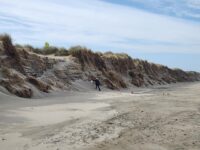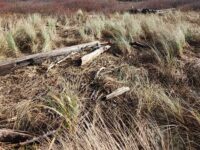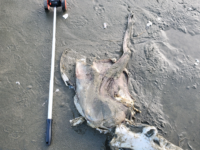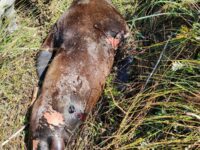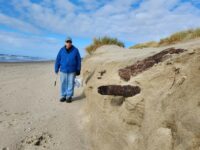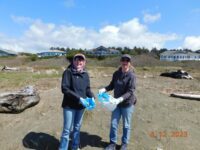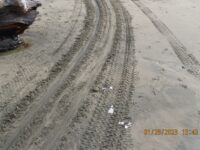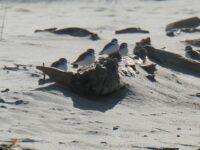Mile 203 Report
Driftwood Beach south, Hidden Lake
April 27, 2020
My neighbor in Bayshore came upon and photographed this rare Western Snowy Plover nest approx 4/23/2020.
Report Details
My neighbor in Bayshore came upon and photographed this rare Western Snowy Plover nest approx 4/23/2020. My neighbor didn't notice any birds incubating the eggs, but snowy plovers are very inconspicuous (see the plover photographs in my Mile 202 reports), and the incubating plover probably ran off without being seen. The photo shows a classic Western Snowy Plover nest, 3 speckled eggs in a shallow depression or scrape in the sand, this nest in a debris field of small rocks safely above the high tide line. Western Snowy Plovers are the only birds, except Killdeers rarely, that nest like this on Oregon's sandy beaches, and no Killdeers, which are highly visible and vocal and usually lay more than 3 eggs, have been seen in the area. When my neighbor told me about the nest, I went out and with her help tried to locate and document it, but the nest was gone without a trace. There are coyotes in the dunes, and Bald Eagles in the area, but no indication of what happened to this nest. A few days later, heavy winds and blowing sand almost covered the rocky debris field, which is now more exposed again after recent rains. Even though the nest was no longer there, I named it DRI202001and reported it to Oregon Parks & Recreation Department, which administers a Western Snowy Plover protection program in cooperation with Portland Audubon and for which I volunteer as a Plover Patrol member. Miles 202 and 203 are not part of an area managed for Western Snowy Plovers, but if active plover nests are located here they are to be protected by OPRD.
Conditions
Temperature: 56 F. Cloud Cover: Partly Cloudy. Wind Velocity: Calm/Light. Wind Direction: SW. Tide Level: 5.6 feet.
Human Activities
Number of people: 19. Number of dogs: 6. Walking or running: 19.
Notable Wildlife
Western Snowy Plover nest -- see photos and Summary
Driftline Content
Small rocks, Shells, Wood pieces. Beach was very clean
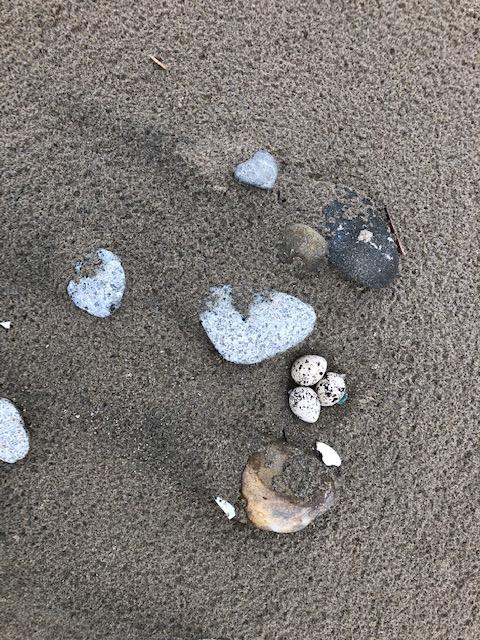


Report Images
All Mile 203 Reports
Mile 203
Driftwood Beach south, Hidden Lake
We found 7 lbs 12 oz of marine and ocean debris on the beaches in the wrackline area. The north and south ends of mile 203 show evidence of substantial wave erosion of the dunes.
Jeff Hildreth
Mile 203
Driftwood Beach south, Hidden Lake
The beach has had substantial washing away of old dunes and washing up of beach grass into the dunes. There were 45 bird carcasses of we believe are Cassin's auklets.
Jeff Hildreth
Mile 203
Driftwood Beach south, Hidden Lake
Today I and my two CoastWatch partners conducted a NOAA Marine Debris survey on our 100 meter survey site at Sandpiper Beach, Mile 203. On reaching our marine debris survey site, we saw a lot of Cassin's Auklet carcasses, which COASST calls CAAU, all high up on the beach among the beach vegetation and washed-in sea grass, many carcasses partially covered by sand or vegetation. After we completed our debris survey, I returned to our survey site and began collecting CAAU carcasses in groups of 9, as COASST recommends, ultimately collecting 40 carcasses in 4 full and 1 partial grouping. Below is a link to our Sandpiper Beach NOAA debris survey site where most CAAUs were found, reached by a boardwalk that enters the beach midway in the debris survey site. COASST defines a "wreck" as more than 20 beached individuals of one species per kilometer, and a "MME" (Massive Mortality Event) as a spike of up to hundreds of carcasses per kilometer. We also found a beached Northern Fulmar and what is I believe was either a female Gadwall or White-winged Scoter, which I took note of but didn't measure or report on to COASST. I submitted documentation with photos of the CAAU beaching event to COASST, and COASST responded that they had received reports of CAAU beachings from Southern Oregon sites like Coquille Point and Cape Blanco but also as far north as Manzanita. All this sounds very dry, but it was really sad to see and handle all these beautiful little dead birds and wonder if this is completely natural or if climate change, and perhaps a decline of prey species making these birds more vulnerable, factors into these mortality events. https://mdmap.
Jon French
Mile 203
Driftwood Beach south, Hidden Lake
The storms and rain caused some beach washout from the ocean and from the land.
JLcoasties
Mile 203
Driftwood Beach south, Hidden Lake
The dunes have reappeared due to the spring winds.
JLcoasties
Mile 203
Driftwood Beach south, Hidden Lake
Last year at this time, Jesse Jones helped us set up a 100 meter NOAA marine debris survey site on Mile 204, which we later moved to Sandpiper Beach on Mile 203.
Jon French
Mile 203
Driftwood Beach south, Hidden Lake
It was a beautiful day for a walk.
Nancy Thomas
Mile 203
Driftwood Beach south, Hidden Lake
After observing 8 snowy plovers on Mile 200 yesterday, I wanted to check up on the plovers on Mile 203.
KFunk

